ECU Citroen BERLINGO MULTISPACE 2015 2.G User Guide
[x] Cancel search | Manufacturer: CITROEN, Model Year: 2015, Model line: BERLINGO MULTISPACE, Model: Citroen BERLINGO MULTISPACE 2015 2.GPages: 298, PDF Size: 12.69 MB
Page 94 of 298
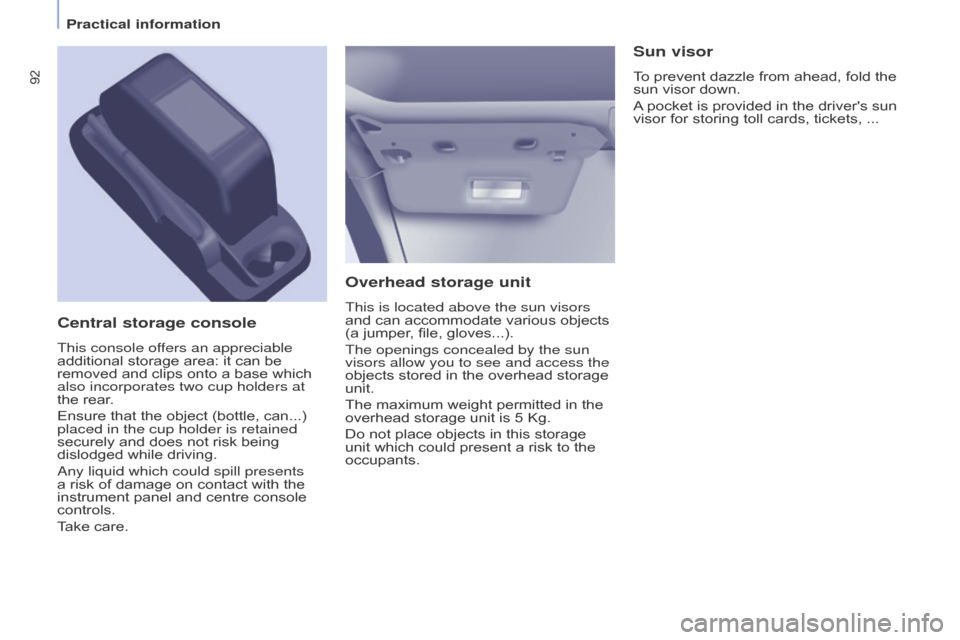
92
Berlingo-2-VP_en_Chap04_Ergonomie_ed01-2015Berlingo-2-VP_en_Chap04_Ergonomie_ed01-2015
Overhead storage unit
This is located above the sun visors
and can accommodate various objects
(a
jumper, file, gloves...).
The openings concealed by the sun
visors allow you to see and access the
objects
stored in the overhead storage
unit.
The
maximum weight permitted in the
overhead
storage unit is 5 Kg.
Do
not place objects in this storage
unit
which could present a risk to the
occupants.
Central storage console
This console offers an appreciable
additional storage area: it can be
removed
and clips onto a base which
also incorporates two cup holders at
the
rear.
Ensure
that the object (bottle, can...)
placed in the cup holder is retained
securely
and does not risk being
dislodged
while driving.
a
ny liquid which could spill presents
a
risk of damage on contact with the
instrument
panel and centre console
controls.
T
ake care.
Sun visor
To prevent dazzle from ahead, fold the sun visor down.
A
pocket is provided in the driver's sun
visor
for storing toll cards, tickets, ...
Practical information
Page 96 of 298

94
Berlingo-2-VP_en_Chap04_Ergonomie_ed01-2015Berlingo-2-VP_en_Chap04_Ergonomie_ed01-2015
SEATING AREA FITTINGS
Floor boxes
Two boxes are available, located under
the rear passenger footwells.
To
open them, slide your fingers into
the
recess and lift the lid.
Aircraft style tables
To put the table in place, pull it
upwards and fold it down.
a
s a safety precaution, above a high
pressure, the table is designed to
unhook.
To
put it back in place, with the table
vertical, engage one side then the
other
, forcing slightly.
Do
not place hard or heavy objects
on
the table.
They
could become
dangerous
projectiles in the event of
sharp
braking or impact.
A
bag hook is provided on the side of
each
table.
Side blinds
Side blinds may be available on the sliding side doors.
Pull the side blind by the tab to install
it.
To
avoid damaging the blind when
opening
the door, check that the tab is
hooked
securely.
a
lways guide the blind slowly
using the tab, both when raising
and
when lowering.
Practical information
Page 101 of 298
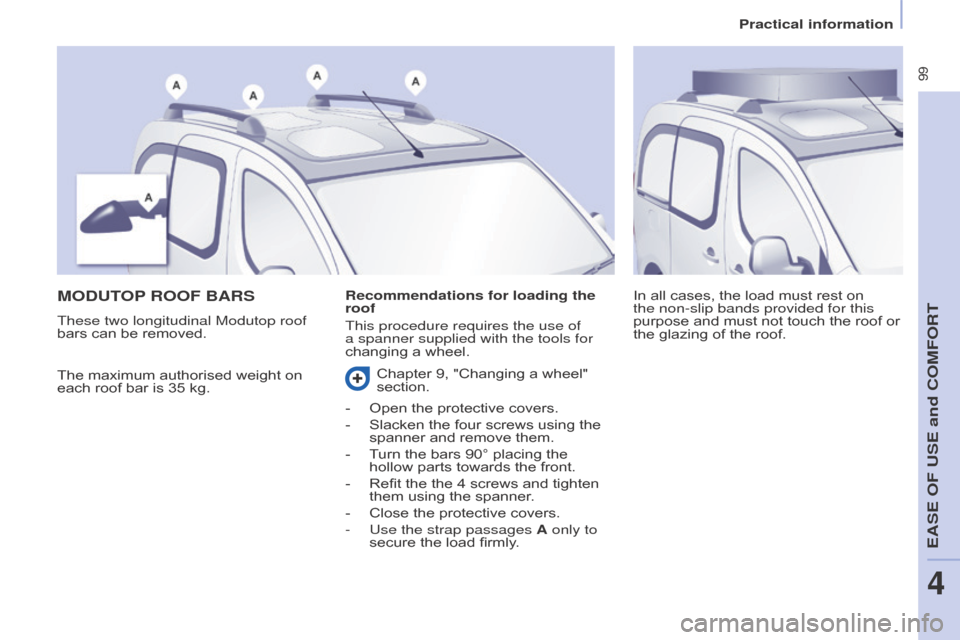
99
Berlingo-2-VP_en_Chap04_Ergonomie_ed01-2015Berlingo-2-VP_en_Chap04_Ergonomie_ed01-2015
MODUTOP ROOF BARS
The maximum authorised weight on each
roof bar is 35 kg. In
all cases, the load must rest on
the non-slip bands provided for this
purpose
and must not touch the roof or
the
glazing of the roof.
Recommendations for loading the
roof
This procedure requires the use of
a spanner supplied with the tools for
changing
a wheel.
These two longitudinal Modutop roof
bars can be removed.
Chapter 9, "Changing a wheel" section.
-
Open
the protective covers.
-
Slacken
the four screws using the
spanner
and remove them.
-
T
urn the bars 90° placing the
hollow
parts towards the front.
-
Refit
the the 4 screws and tighten
them
using the spanner.
-
Close
the protective covers.
-
Use the strap passages
A only to
secure
the load firmly.
EASE OF USE and COMFORT
4
Practical information
Page 105 of 298
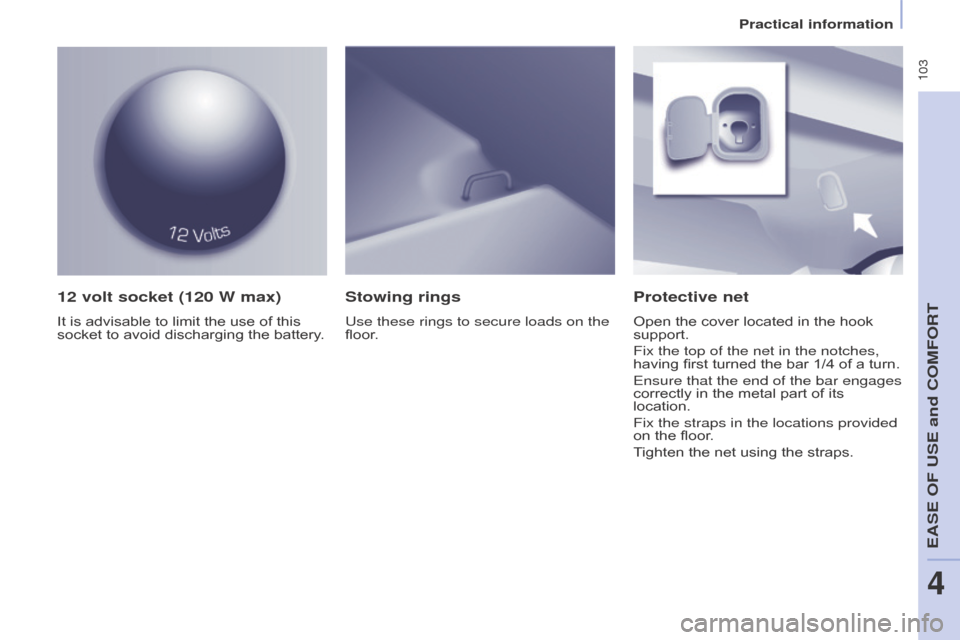
103
Berlingo-2-VP_en_Chap04_Ergonomie_ed01-2015Berlingo-2-VP_en_Chap04_Ergonomie_ed01-2015
12 volt socket (120 W max)
It is advisable to limit the use of this socket to avoid discharging the battery.
Protective net
Open the cover located in the hook support.
Fix the top of the net in the notches,
having
first turned the bar 1/4 of a turn.
Ensure that the end of the bar engages
correctly
in the metal part of its
location.
Fix the straps in the locations provided
on
the floor.
Tighten
the net using the straps.
Stowing rings
Use these rings to secure loads on the
floor.
EaSE oF USE and CoMFoRT
4
Practical information
Page 106 of 298
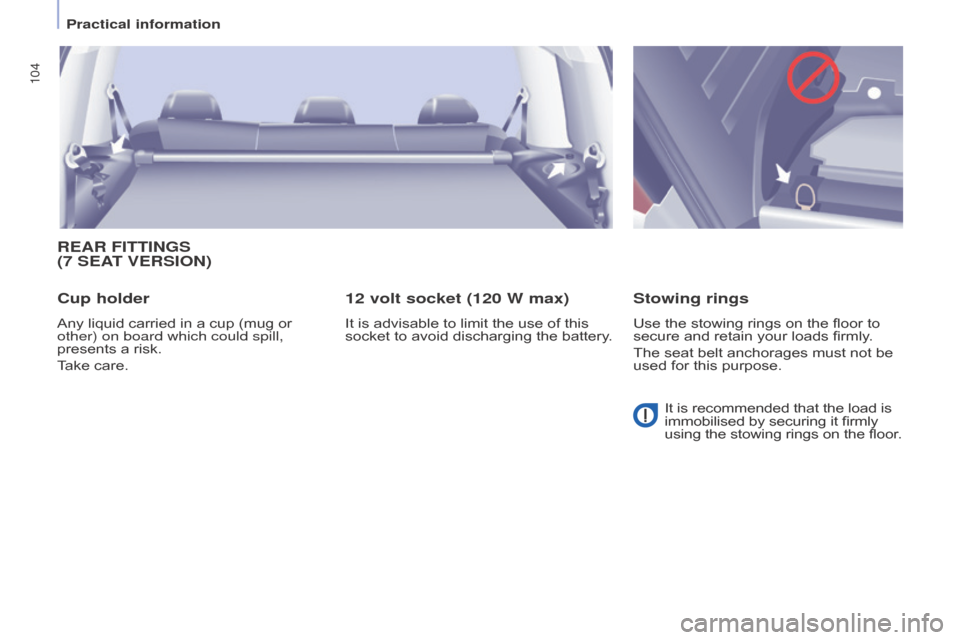
104
Berlingo-2-VP_en_Chap04_Ergonomie_ed01-2015Berlingo-2-VP_en_Chap04_Ergonomie_ed01-2015
REAR FITTINGS
(7 SEAT VERSION )
Cup holder
Any liquid carried in a cup (mug or other) on board which could spill,
presents a risk.
Take
care.
12 volt socket (120 W max)
It is advisable to limit the use of this socket to avoid discharging the battery.
Stowing rings
Use the stowing rings on the floor to secure and retain your loads firmly.
The
seat belt anchorages must not be
used
for this purpose.
It
is recommended that the load is
immobilised
by securing it firmly
using
the stowing rings on the floor.
Practical information
Page 112 of 298

11 0
Berlingo-2-VP_en_Chap04_Ergonomie_ed01-2015Berlingo-2-VP_en_Chap04_Ergonomie_ed01-2015
ELECTRIC WINDOWS
Lower the window fully, then raise it, it
will rise in steps of a few centimetres
each
time the control is pressed.
Repeat the operation until the window
is
fully closed.
Continue to press the control for at
least one second after the window
closed
position has been reached.
The safety anti-pinch does not operate
during
these operations.
Safety anti-pinch
When the window rises and meets an obstacle, it stops and partially lowers.
Manual mode
This mode is available depending on equipment; it is
identified
by this symbol on the
control
in question.
Good practice
If the electric windows meet an obstacle during operation, you must
reverse
the movement of the window.
T
o
do
this,
press
the
control
concerned.
When the driver operates the
passenger electric window controls,
they
must ensure that no one is
preventing correct closing of the
windows.
The
driver must ensure that the
passengers use the electric windows
correctly
.
Be aware of children when operating
the
windows.
Following
several consecutive closing/
opening operations of the electric
window
control, a protection system
is triggered which only allows closing
of
the window.
After
closing, wait
approximately
40 minutes. Once this
time
has elapsed, the control becomes
operational
again.
1.
d
river's side
2.
Passenger's side
Reinitialisation
Following reconnection of the battery,
or in the event of a malfunction, the
safety
anti-pinch function must be
reinitialised. The electrical functions of the electric
windows
are deactivated:
-
approximately
45 seconds after the
ignition is switched of
f,
-
after one of the front doors is
opened,
if the ignition is off.
There
are
two
operating
modes:
Press or pull the control, without
passing
the
point
of
resistance.
The window stops when you release
the
control.
One-touch mode
Press or pull the control, beyond the
point
of resistance.
The window opens or closes fully when
the
control is released.
Pressing or pulling the control again
stops
the movement of the window.
Mirrors and windows
Page 113 of 298

111
Berlingo-2-VP_en_Chap05_Securite_ed01-2015
HAZARD WARNING LAMPS
H
ORN
Press the centre of the steering wheel.
PARKING BRAKE
Applying
Pull the parking brake lever up to immobilise
your vehicle.
Check
that the parking brake is applied
firmly
before leaving the vehicle.Pull
on the parking brake lever, only
with the vehicle stationary.
In the exceptional case of use of the
parking
brake when the vehicle is
moving,
apply the brake by pulling
gently
to avoid locking the rear wheels
(risk
of skidding).
Press this button, the direction
indicators
flash.
They
can
operate
with
the
ignition
off.
The
hazard
warning
lamps
should
only
be used in dangerous situations, when
stopping
in
an
emergency
or
when
driving
in
unusual
conditions.
When
parking on a slope, direct your
wheels
towards the pavement and pull
the
parking brake lever up.
There is no advantage in engaging
a
gear after parking the vehicle,
particularly
if the vehicle is loaded.
If the parking brake is still on or has not been released properly, this is
indicated
by this warning lamp which
comes
on on the instrument panel.
Automatic operation of hazard
warning lamps
When braking in an emergency, depending on the force of deceleration,
the hazard warning lamps come
on
automatically.
They
switch off
automatically
the first time you
accelerate.
It
is also possible to switch them off by
pressing
the switch on the dashboard.Releasing
Pull the lever up slightly and press the
button to lower the parking brake lever.
driving safely
SaFETY
5
Page 114 of 298
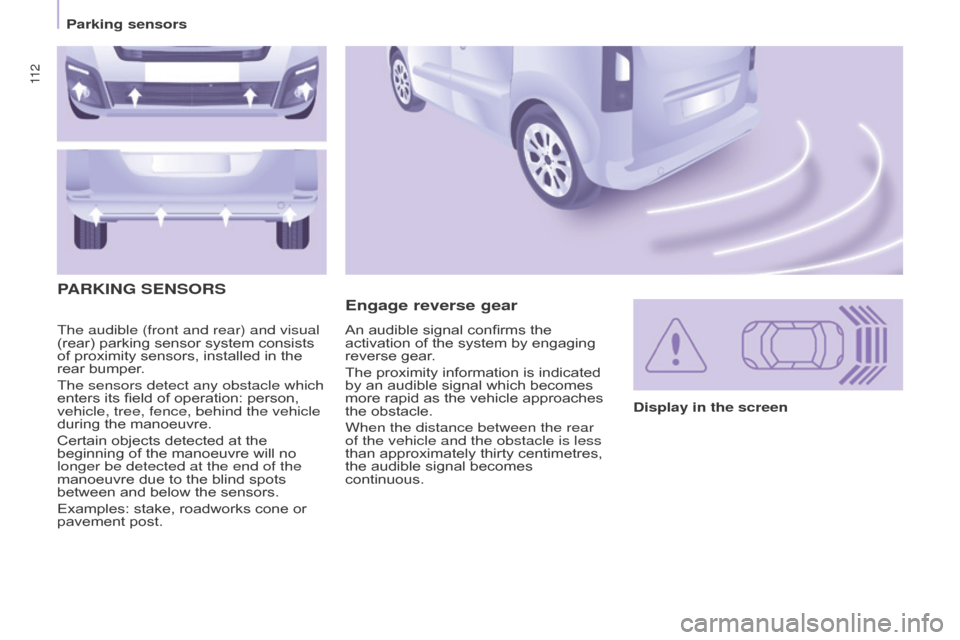
11 2
Berlingo-2-VP_en_Chap05_Securite_ed01-2015
The audible (front and rear) and visual
(rear) parking sensor system consists
of
proximity sensors, installed in the
rear
bumper.
The sensors detect any obstacle which
enters
its field of operation: person,
vehicle, tree, fence, behind the vehicle
during
the manoeuvre.
Certain
objects detected at the
beginning
of the manoeuvre will no
longer be detected at the end of the
manoeuvre
due to the blind spots
between
and below the sensors.
Examples:
stake, roadworks cone or
pavement
post.
Engage reverse gear
P
ARKING
SENSORS
Display in the screen
An
audible
signal
confirms
the
activation
of
the
system
by
engaging
reverse
gear.
The
proximity
information
is
indicated
by
an
audible
signal
which
becomes
more
rapid
as
the
vehicle
approaches
the
obstacle.
When the distance between the rear
of the vehicle and the obstacle is less
than
approximately
thirty
centimetres,
the
audible
signal
becomes
continuous.
Parking sensors
Page 115 of 298
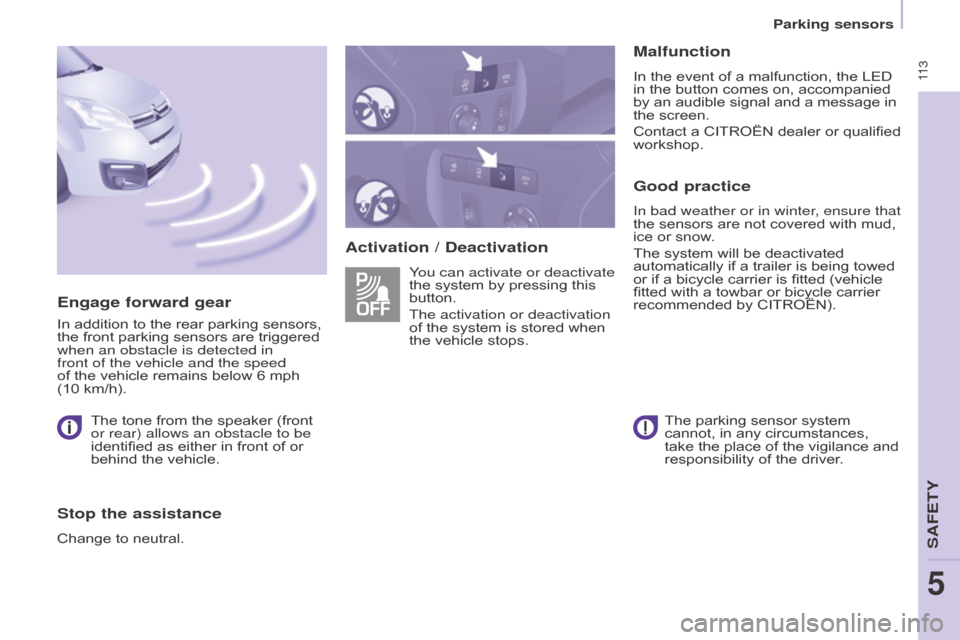
11 3
Berlingo-2-VP_en_Chap05_Securite_ed01-2015
Activation / DeactivationMalfunction
In the event of a malfunction, the LED in
the button comes on, accompanied
by
an audible signal and a message in
the
screen.
Contact
a CITROËN dealer or qualified
workshop.
Good practice
In bad weather or in winter, ensure that
the sensors are not covered with mud,
ice
or snow.
The
system will be deactivated
automatically
if a trailer is being towed
or
if a bicycle carrier is fitted (vehicle
fitted
with a towbar or bicycle carrier
recommended
by CITROËN).
You can activate or deactivate
the
system
by
pressing
this
button.
The activation or deactivation
of
the
system
is
stored
when
the
vehicle
stops.
Engage forward gear
In addition to the rear parking sensors, the front parking sensors are triggered
when an obstacle is detected in
front of the vehicle and the speed
of
the vehicle remains below 6 mph
(10 km/h).The
tone from the speaker (front
or rear) allows an obstacle to be
identified
as either in front of or
behind
the vehicle.
Stop the assistance
Change to neutral. The parking sensor system
cannot,
in any circumstances,
take
the place of the vigilance and
responsibility
of the driver.
Parking sensors
SaFETY
5
Page 116 of 298
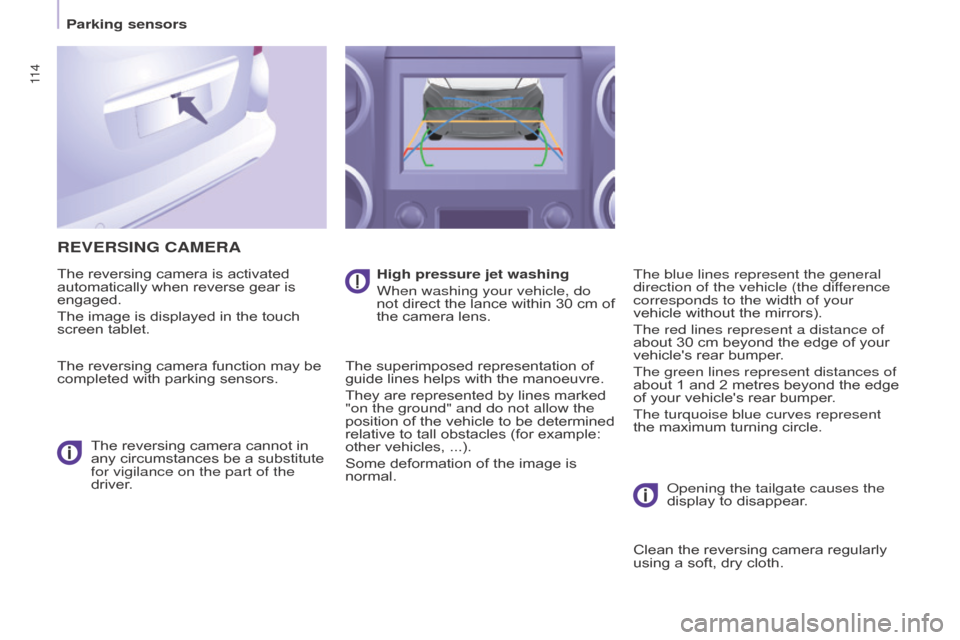
11 4
Berlingo-2-VP_en_Chap05_Securite_ed01-2015
REVERSING CAMERA
The reversing camera is activated automatically when reverse gear is
engaged.
The
image is displayed in the touch
screen
tablet.
The
reversing camera function may be
completed
with parking sensors.
The
reversing camera cannot in
any
circumstances be a substitute
for vigilance on the part of the
driver
. High pressure jet washing
When washing your vehicle, do
not
direct
the
lance
within
30
cm
of
the
camera lens.
The
superimposed representation of
guide
lines helps with the manoeuvre.
They
are represented by lines marked
"on the ground" and do not allow the
position
of the vehicle to be determined
relative
to tall obstacles (for example:
other
vehicles, ...).
Some
deformation of the image is
normal.The blue lines represent the general
direction of the vehicle (the dif
ference
corresponds to the width of your
vehicle
without the mirrors).
The red lines represent a distance of
about
30 cm beyond the edge of your
vehicle's
rear bumper.
The green lines represent distances of
about
1 and 2 metres beyond the edge
of
your vehicle's rear bumper.
The turquoise blue curves represent
the
maximum turning circle.
o
pening the tailgate causes the
display
to disappear.
Clean
the reversing camera regularly
using
a soft, dry cloth.
Parking sensors